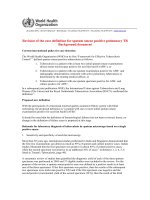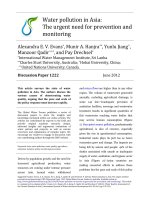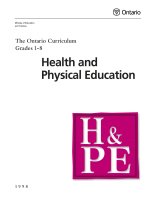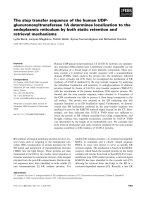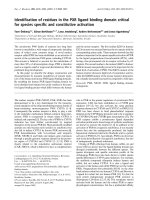Protecting the Elderly in Times of Disaster: The Critical Need for Comprehensive Disaster Planning and Exercise Design doc
Bạn đang xem bản rút gọn của tài liệu. Xem và tải ngay bản đầy đủ của tài liệu tại đây (47.55 KB, 7 trang )
Forum on Public Policy
Protecting the Elderly in Times of Disaster: The Critical Need for
Comprehensive Disaster Planning and Exercise Design
James C. Hagen, Director of the Disaster Preparedness and Management Program,
Saint Xavier University
Abstract
Of vital concern internationally is the protection of one of our most vulnerable populations, the elderly, in times of
disaster. This is especially true when the threat of disasters, both man-made and natural, is increasing. Recent
disasters in the United States, especially Hurricane Katrina, have proven the inadequacy of current planning. It has
been shown that 91% of long term care (LTC) health professionals and other providers felt ill-prepared to deal with
public health emergencies and bioterrorism threats. Concern for the quality of life for LTC community residents
and those elderly living at home must include intensive planning and preparation for emergencies/disasters that
would compromise the safety of these most at-risk loved ones.
The optimal approach to improving the ability of LTC communities to respond lies in appropriate, targeted,
and effective training concerning how to create/exercise plans to respond to, and recover from, disasters. This work
addresses major issues and challenges of disaster planning for the elderly. Suggestions are provided for concrete
action, and a there is a call for the LTC community to move forward in being included in future planning efforts and
the exercising of these plans.
Introduction
Recent disasters in the United States, especially Hurricane Katrina, have proven the
inadequacy of planning for the protection and safety of our vulnerable populations. The
vulnerable, or special, populations can be categorized in many ways, including those with
physical disabilities, who have cognitive impairment or mental illness, who are incarcerated,
who speak English as a second language or not at all, and who are elderly. This paper concerns
primarily the elderly who live in congregate care settings, including independent living, assisted
living, long term care, or continuing care retirement communities (CCRF). Concern for quality
of life of older residents must today, more than ever before, include intensive planning and
preparation for emergencies and disasters that would compromise the safety of our most at-risk
elderly. As a striking example from Hurricane Katrina, of the 1330 deaths, nearly half of the
victims were over 75 years of age, and approximately 71% of those who died were over 60 years
of age (AARP 2006).
Five factors most negatively affect the ability of LTC communities to adequately respond
to disasters: 1) Mobility and functional limitations pose serious challenges for the elderly
receiving LTC services should there be a disaster, whether that be man-made or natural. Sixty
three percent of elders living in assisted living/retirement living communities have limitations in
one or more activities of daily living (ADL’s). 2) Cognitive impairment from many causes
limits the understanding and ability of elders to rapidly respond in an emergency situations. 3)
High turnover rate of nurses, nurse assistants, and LTC administrators requires constant training
of staff. 4) Appropriate care of the elderly in emergency situations requires geriatric training of
medical professionals, and is a serious lack in this area. 5) There is a lack of training and
education concerning how to prepare emergency plans and exercise those plans appropriately.
The most effective approach to improving the ability of LTC communities to respond lies
in creating appropriate all hazards plans and targeted hazard specific annexes, and then
practicing (exercising) these plans appropriately. This will create a cadre of trained professionals
to respond to, and recover from, disasters.
1
Forum on Public Policy
In collaboration with the American College of Health Care Administrators (ACHCA), a
web-based survey was sent to nearly half of their national LTC members by Mather Lifeways
Institute on Aging in March 2005. There were respondents from 194 of these facilities across 30
states. Half of the respondents were from CCRF, while the other half were from nursing homes.
This was done to determine the need for training within the LTC workforce. Questions were
aimed at preparedness for public health emergencies, including the threat of bioterrorism (BT).
Very little thought has been given to the serious ramifications of BT on senior populations (Root
et al. 2007). Although at that point, the challenges of a potential Pandemic Influenza were not
being considered, this risk is now also being addressed by the training. Avian Influenza has
continued its march across Europe and remains a serious threat (Revill 2007; Shaikh 2007). In
this survey, 91% of senior living (SL) and long term care (LTC) administrators felt ill-prepared
to deal with public health emergencies and BT threats. Eighty percent of the respondents
reported that their LTC communities did not have any training (either educational or exercise
based) for their workforce in this area. Moreover, 81% were not aware of emergency plans for
older adults in their states. When asked what the key issue was in their state or region related to
emergency/BT preparedness, 82% said that there is a lack of coordination of emergency and
social service networks in their states/regions to provide and comprehensive resources to LTC
communities. The PREPARE train-the-trainer program was created in response to the lack of
emergency preparedness by SL and LTC residences. A grant was awarded to Mather LifeWays
Institute on Aging by the Office of the Assistant Secretary for Preparedness and Response, U.S.
Department of Human Services to provide this training around the nation. By April 2007, over
3600 SL/LTC healthcare professionals had been trained. The program has reached providers in
over 33 states through train-the-trainer sessions and conferences. Much of the information
provided in this report was gained or substantiated through extensive interaction with providers
around the United States and internationally. Ultimately through a large evaluation component,
impact of the training on preparedness, creation of plans, and staff will be reported.
This paper examines the need for LTC comprehensive disaster planning, major
considerations, and the exercises that must follow if a LTC community is to be adequately
prepared for the disasters they might face. Both physical and mental health realities must be
taken into account when creating a plan for this population. There must be communication and
coordination of all response sectors.
Questions That are Posed During Training Session
There are several questions that are posed at the beginning our two day train-the-trainer
sessions and conference intensives. They are used to raise the awareness of issues that might not
have already been discussed or addressed in the long term care setting. They serve the purpose
of helping staff and administrators focus their attention and efforts on important areas of
consideration. Some of these questions are as follows:
• Do you know about your Emergency Management Agency and who represents you
there?
• Do you have backup energy sources? How long do your generators function. Do you
have enough fuel and what if you can’t obtain more?
• What considerations have you made for special needs residents within the elderly
population, such as cognitively impaired, Alzheimer’s, post-traumatic stress disorder,
high-risk fall patients, or those on ventilators?
2
Forum on Public Policy
• What type of communication mechanisms do you have with your local health department
concerning your response to disasters, including Pandemic Influenza? What
communications and exercises have you been involved in with them?
• How will you receive antiviral agents or vaccines if/when the time comes? Where are
you on the priority list?
• Who would create a prioritization scheme for who gets the medication and how would
they do it?
• Should you stockpile – what and how much?
• Are you equipped to be a shelter during disasters, or to act as an alternate care site when
hospitals become overwhelmed?
• What might you do if only 60% of your staff show up to work?
Basic Areas of Concern
This paper will examine 5 areas of concern for SL/LTC communities as they prepare and
improve their ability to respond to disasters.
Area 1. Lack of understanding of what comprises a “vulnerable population”, and the implication
for this group prior to, and during, a disaster.
Area 2. Lack of adequate understanding and training of the first responder community
concerning the special needs of these populations.
Area 3. Lack of understanding of the importance of a Hazard Vulnerability Assessment in
preparation of an All Hazards Plan, and appropriate hazard-specific Annexes.
Area 4. Importance of inventory and stockpiling based on the planning process.
Area 5. Need for both evacuation and sheltering-in-place plans, and for the exercising of both.
Area 1 - What is a “Vulnerable Population?”
There has been much discussion in recent months concerning who might be included in
the population of “vulnerable” residents. The term “vulnerable” has most often been used
interchangeably with the term “special needs.” In the most broad sense as related to disaster
management, the vulnerable population refers to those individuals who do not feel they can
adequately access the resources they need during all four phases of a disaster: preparedness,
response, recovery, and mitigation. This would encompass a huge number of people and
populations, including the elderly, physically handicapped (deaf, blind, disabled, etc), mentally
disabled or cognitively impaired, those dependent on medicines or mechanical devices,
homeless, poor, non-English speaking, and children. Each population is to be valued and
protected, although the planning for each will vary to different degrees. The purpose of this
paper is to focus on the elderly population, and more specifically to those who live in retirement
communities or congregate care settings. There is no question that the issues addressed apply to
all those who are vulnerable, but the ways in which each issue is approached will differ.
The elderly easiest to locate are residents living in extended care congregate care settings.
This includes the elderly at each level of care (independent, assisted, dementia care, or nursing),
in a Continuing Care Retirement Community, in rehabilitation facilities, and in other specialized
care settings. Work is being done to create databases with addresses, contacts, and
communication systems with such facilities. A greater challenge is locating those living
independently, living alone, or utilizing the care of other individuals or home health. It is
disturbing that those who most need preparation and care during disasters are often those who
fear for their everyday safety by hiding themselves from those around them. There is a
misconception that due to the accumulated wealth of a lifetime of experiences, the elderly will be
more resilient to the stresses of loss, emotional upheaval, and change. In fact, it has been shown
3
Forum on Public Policy
(Oriol 1999) that elders are particularly vulnerable to psychological stresses associated with
crises and disaster. Literature concerning the 1995 Chicago heat wave (Semenza et al. 1995)
demonstrates the devastating toll physical stress took on the elderly living alone and forgotten in
sweltering apartments who were afraid to open their windows, and were too poor to have fans or
obtain the needed food and water for survival. Some public health department and other
government agencies are working together to go door-to-door to find these hidden residents, help
them prepare, and to be able to reach them if needed during a disaster. Issues addressed in this
paper apply to these harder to reach populations as well, but much more work is necessary to
make them prepared.
Area 2 - Adequate Training of the First Responder Community
Although there are required evacuation drills, tornado drills, and other drills depending
on the area of the country, it has most often been found that there is insufficient communication
and collaboration between the first responder community and those in SL/LTC settings. Full
evacuations are not often performed due to resource limitations and actual risk to residents in
such circumstances. Plans on paper may be insufficient to realize the cognitive and mobility
constraints that make evacuation and transportation of this population very different than with
younger or more physically and mentally able populations. Approximately 50% of all nursing
home residents, and 42% of residents living in assisted living programs have some form of
dementia (Alzheimer Association 2007). It is strongly suggested that there be special training
programs set up to inform the first responders as to specific needs, as well as specific actions,
that should and should not be used with these citizens. The University of New Mexico has
published a guide (Center for Development and Disability 2007) that addresses many of these
issues in an easily used, bullet-point format to and provide specific guidance. This document, or
others like it, can be used in sessions where those in LTC can meet with the first responders in a
short session to highlight main issues and answer questions. We have seen this type of training
initiated by the public health department, by emergency management, by hospitals, or by the
retirement communities themselves. In each case, valuable information was shared in both
directions, and everyone benefits. It is tragic that in recent disasters, many LTC communities
had plans in place, but had never worked with staff to review or practice the plans (HHS 2006),
let alone involve the first responder community in these activities.
Area Three - The Hazard Vulnerability Assessment
It is clear that most retirement communities have some level of disaster plans that tend to
be based on two driving forces. The first force driving the creation of plans is as a response to
regulations or laws that exist in their area or state. These tend to be drills rather than the more
valuable exercises that bring all of the involved parties together to discuss interactions during a
disaster response. The second driving force is what history suggests to be the most likely
disaster. Although important and valuable in creation of disaster plans, this approach neglects
the changing natural environment, ignores those risks that may exist a short distance away in
terms of nuclear or chemical hazards, and does not address the risks of terrorism or pandemic
disease that face our world today.
It is vital that each facility or organization conduct a Hazard Vulnerability Assessment
(HVA) to recognize and address potential hazards that threaten them. This allows the
identification of specific hazards that may be addressed and planned for in hazard-specific
Annexes. A good Hazard Vulnerabilty Assesment Tool will take into account the probability of
4
Forum on Public Policy
all types of disasters, the human, property, and business impact of the event, as well as the
internal and external resources available to respond. (Nebraska Hospital Association 2007).
Area Four - Importance of Inventory and Stockpiling Based on the Planning Process
There is both controversy and confusion concerning appropriate stockpiling in order to be
prepared for disasters. If we are to be self-sufficient and “on our own” for prolonged time
periods, there must be some level of critical supplies stored on-site. Most documents acting as
checklists, or that address LTC preparedness, will site the need for such stockpiling, but neglect
to give recommendations or provide specific numbers (Department of Health and Human
Services 2007; Montgomery County Advanced Practice Center for Public Health Preparedness
and Response 2007; Krause 2007). This lack is primarily because no one really knows how
much will be enough. It is entirely dependent on the type of disaster, integrity of supply chains,
and acuity of residents. Stockpiled supplies include food, water, generator fuel, and medical
supplies such as medications, vaccines, oxygen, gloves, masks, and disinfectant. Often used as
an extreme example, Avian Influenza is continuing its march across the globe, although it has yet
to be definitively identified as reaching the United States. Great effort and extensive resources
have been spent in preparing ourselves for this likelihood of Avian Influenza, and the possibility
of Pandemic Influenza. The potential for pandemic is still disturbingly real. It is unfortunate
that by being inundated with information pertaining to how to prepare ourselves for Pandemic
Influenza, most of our population is no longer listening. Recent history has taught us that we
must prepare ourselves on a local level to be alone for extended periods of time without external
assistance.
One of the most daunting of stockpiling issues continues to be medications, both the
everyday medications used by our residents, and the potential of stockpiling antibiotics,
vaccines, and antiviral agents. This will take very serious consideration of such issues as
appropriate storage, shelf-life, prioritization of limited supplies, and the protection of these
materials during disasters (Florida Health Care Association 2007). LTC staff look to their
employers to provide guidance, education, protection, and a safe workplace. LTC administration
must look to public health and emergency management for guidance in these areas.
Although it has been suggested that we store one gallon of water per day per person for
drinking and five gallons of water per day per person for all uses, guidance concerning how
many days to plan for has varied. Such thinking is antithetical to most businesses that have
changed from stockpiling and keeping inventories, into a “just-in-time” mentality. We are now
being asking to consider shifting in the opposite direction yet again. Despite this fact, it is
imperative that the level of supplies on hand be well-monitored, well-controlled, and kept at a
level that has been carefully thought out and pre-determined. In other words, the level of each
item should have been considered with disaster scenarios in mind. The most logical approach is a
four step process. First, there needs to be a clear usage pattern established for those items
deemed to be “critical supplies.” Information on increased usage during critical situations in the
past, such as infectious outbreaks or infrastructure damage would be extremely useful. Second,
determine the time period for which you plan to be without assistance. Third, determine what
would need to be kept on hand to accommodate that time frame. This will vary significantly on
your environment, especially based on a rural or urban setting, type of disaster, and availability
of suppliers. Fourth, make a rational well-reasoned decision, based on your calculations,
available space, and funding for such an endeavor. You must remember to take into account the
staff time it will require to rotate supplies, and keep such inventories in appropriate, protected
5
Forum on Public Policy
conditions. Of course, having contracts for supplies and medications with one or two layers of
backup suppliers is also critical. For example, at what point do you have the least amount of
medications on-site, and would this be sufficient if that supply chain was abruptly terminated?
Area Five - Need for Evacuation and Sheltering-in-place Plans, and for the Exercising of
Both.
In general, evacuation plans are in place for all long term care settings. What varies most
is how much has been actually tested, and what sectors have been involved in these drills and
exercises. In many cases, the drills have been mostly simulated, the first responders and
transportation mechanisms have not been adequately involved, and tracking systems and the
mechanics of moving residents with documentation and medications have not been tested.
Evacuation plans and drills must be taken to the next level of preparedness by involving all
sectors and actually testing as much as possible.
It is the sheltering-in-place concept that has not been adequately planned or tested. As
Annexes are created to address vulnerabilities, it is realized that many disasters involving the
elderly population will require staying in place, sometimes for prolonged time periods, rather
than evacuation (Florida Health Care Association 2007). These plans must be created and tested
as well. Issues discussed earlier pertaining to supply chains and stockpiling are paramount here.
In general, plans are useless if not tested. This was again demonstrated through the
Katrina disaster. When examining 20 SL/LTC residences with approved disaster plans, all had
major issues when attempting to implement those plans during the hurricane (Department of
Health and Human Services 2006).
Conclusion
Several issues relating to the inclusion of elderly populations and all those considered vulnerable,
into planning and exercising of plans have been included in this discussion. It is both an ethical
and moral imperative that we care for those who cannot care for themselves in times of crisis and
disaster. Those caring for the vulnerable elderly must better prepare themselves, their facilities,
and their organizations for disasters occurring from both natural and man-made causes. Recent
disasters, planning efforts, and community exercises continue to highlight the planning and
exercising needed in this area. Interest continues to increase, as well as recognition at state and
federal levels that there must be inclusion, rather than exclusion, of those involved in geriatric
care in the preparedness of our nation. In recent months and years, those in long term care
should prepare themselves to be questioned by public health, emergency management, other
regulatory bodies, and the families of our residents as to what is being done to prepare and
protect those for whom we provide care. Five areas of major concern were addressed in this
paper, as well as immediate actions that need to be taken to begin addressing each. It is time that
our facilities become more prepared, create the contacts and collaborations necessary, and assure
sure that staff are adequately informed and exercised in plans created for times of crisis.
References
AARP (2007). We Can Do Better: Lessons Learned in Protecting Older Persons in Disasters Report and Conference
Summary. Retrieved May 23, 2007, from http:/assets.aarp.org/rgcenter/il/better.pdf
Alzheimer’s Association, American Association of Homes and Services for the Aging, American Health Care
Association, American Health Quality Association, American Medical Directors Association, National
Association of Directors of Nursing Administration, National Center for Assisted Living. Planning for a
Pandemic/Epidemic or Disaster: Caring for Persons with Cognitive Impairment.
pandemic_dementia_care.pdf (accessed September 8, 2007).
6
Forum on Public Policy
7
Center for Development and Disability. Tips for First Responders. Albuquerque, New Mexico.
(accessed August 28, 2007).
Department of Health and Human Services (HHS) and The Centers for Disease Control and Prevention (CDC).
Long-Term Care and Other Residential Facilities Pandemic InfluenzaPlanning Checklist.
LongTermCareChecklist.html (accessed September 6, 2007).
Department of Health and Human Services (HHS) Office of Inspector General (OIG) HHS/OEI-06-06-00020. 2006.
HHS; Nursing Home Emergency Preparedness and Response During Recent Hurricanes. Washington, DC:
Government Publishing Office.
Florida Health Care Association. Caring for Vulnerable Elders During a Disaster: National Findings of the 2007
Nursing Home Hurricane Summit.
clinical/SUMMIT%20REPORT%20FINAL.pdf (accessed September 8, 2007).
Krause Ryoko. 2007. Business Continuity Planning for the Global Healthcare Industry. International Federation
of Pharmaceutical Manufacturers and Associations.
Industry_Jan_2007.pdf .
Montgomery County Advanced Practice Center for Public Health Emergency Preparedness and Response.
Emergency Preparedness Checklist for Nursing Homes, Assisted Living Facilities, and Group Homes.
content/hhs/phs/APC/apcnursinghomeassess.pdf (accessed
September 10, 2007).
Nebraska Hospital Association. Hazard Vulnerability Analysis: Assessing Risk to Patients and Preparing For all
Disasters. index.htm?topic=details&news_id=609 (accessed September 10,
2007).
Oriol, William. 1999. Psychosocial Issues for Older Adults in Disasters. http://
download.ncadi.samhsa.gov/ken/pdf/SMA99-3323/99-821.pdf (accessed September 8, 2007).
Revill, Jo. It’s Too Early to Panic, But We Should Prepare.
uk_news/story/0,,2005574,00.html. The Observer, United Kingdom. February 4, 2007.
Root, Elisabeth C., Jacqquline B. Amoozegar, and Shulamit Bernard. 2007. Nursing homes in public health
emergencies: special needs and potential roles. AHRQ Publication No. 07-0029-1. Rockville, Maryland.
Agency for Healthcare Research and Quality.
Semenza, , Jan C., Carol H. Rubin, Kenneth H. Falter, Joel D. Selanikio, Dana Flanders, Holly L. Howe, and John
L. Wilhelm. 1995. Heat-related deaths during the July 1995 heat wave in Chicago. New England Journal of
Medicine. 335: 84-90.
Shaikh, T. Bird Flu Alert as 1,000 Turkeys Found Dead in Suffolk.
birdflu/story/0,,2005157,00.html. The Guardian, United Kingdom. February 3, 2007.
Published by the Forum on Public Policy
Copyright © The Forum on Public Policy. All Rights Reserved. 2006.


